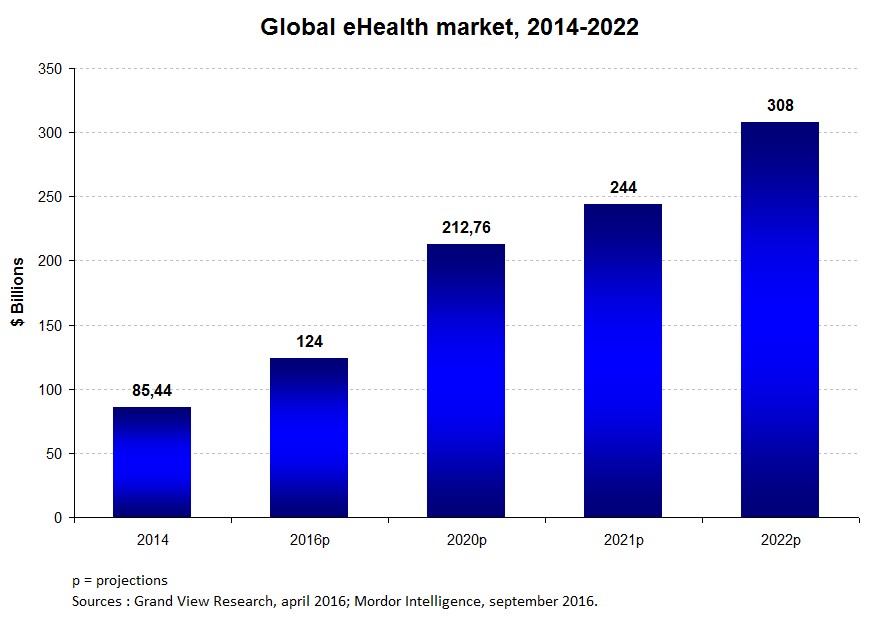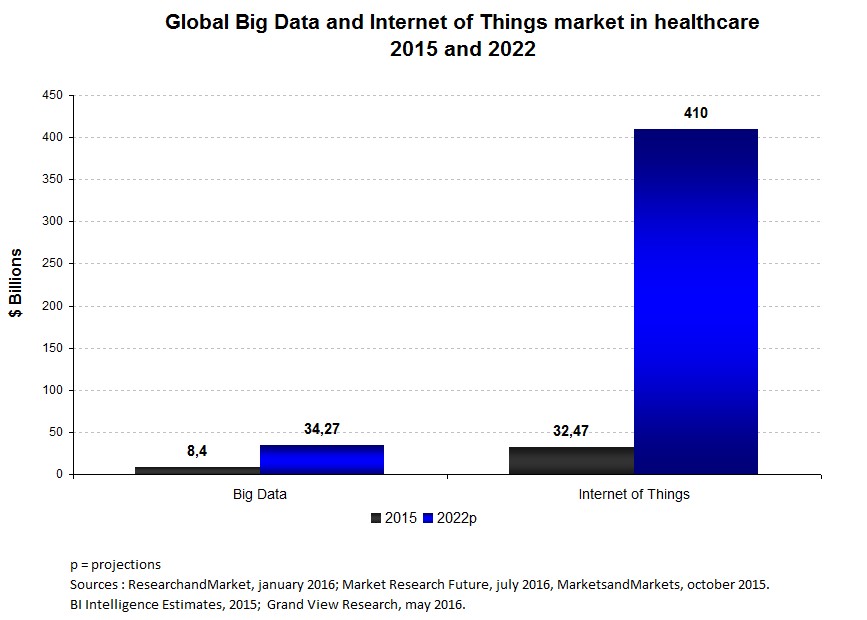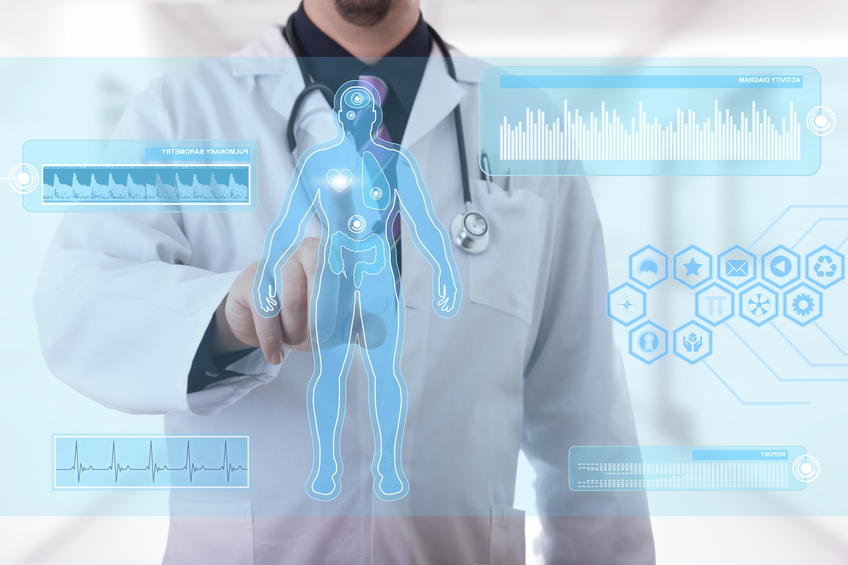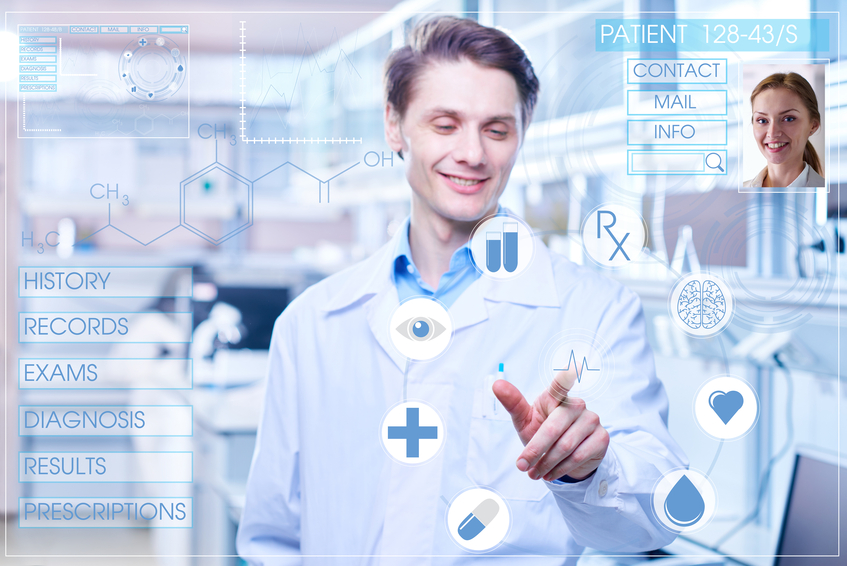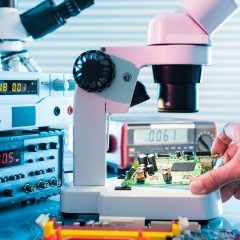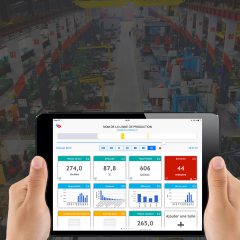New technologies are among the driving forces behind the growth of the health industry, and their application is widely referred to as eHealth (digital or connected health).
The term refers to the use of information and communications technologies (ICTs) in all health-related activities involving both patients and professionals. eHealth takes in a range of digital applications aimed at preventing, diagnosing and treating disease, including the following:
- Telemedecine: The medical practice that allows the patient to connect remotely with one or more health professionals, and health professionals to connect remotely with one another for purposes of establishing a medical diagnosis;
- Medical telemonitoring: An aspect of telemedicine that allows a health professional to remotely monitor and interpret a patient’s medical parameters in real time;
- mHealth (for “mobile health”): Makes it possible to deliver health services using mobile devices, smart phones or devices with a mobile network connection.
This new and inspiring practice has emerged, increasingly, as a solution to the major challenges of our times, notably those stemming from the aging of the population and the growing burden of chronic diseases (i.e., cancer, hypertension, diabetes, heart failure, Parkinson’s disease, etc.). eHealth makes it possible, in part, to monitor patients in real time, practice effective and optimal resource management, offer more timely and accurate diagnoses, improve treatment outcomes, and achieve earlier detection of chronic diseases.
The following recent technologies have been recognized for their considerable potential in the health sector:
- Internet of things (or IoT): An information infrastructure that makes it possible to interconnect things (physical or virtual) using a communication system (RFID chips, Bluetooth, Wi-Fi, etc.). In health, IoT can be used to connect several medical devices for purposes of providing information in real time to professionals or managers. IoT produces large amounts of data commonly called “Big Data”;
- Big Data: Literally refers to a massive amount of data that a classical information management tool alone cannot process. This massive amount of data may be presented in different forms, including digital numbers, images, videos and audio content. The analysis of Big Data in health makes it possible to contextualize the data in order to obtain a more accurate picture of the medical problem treated. The ever-increasing volume of these data calls for means other than classical tools to process them, which is where artificial intelligence plays a part.
- Artificial intelligence: Designates a set of techniques implemented for purposes of allowing machines to simulate human intelligence in order to resolve complex problems. It can be used in a variety of approaches, notably automatic learning (or machine learning) and deep learning. The latter imitates neuronal function in the human brain for purposes of teaching a machine how to independently identify and classify data. It used to be necessary to define each rule a tool had to follow in order to understand and classify information. Machine learning, for its part, allows machines to automatically execute instructions contained in algorithms.
Thanks to artificial intelligence, the ever-increasing volume of data and growing computing power, it is now possible to construct algorithms that generate automatic and more accurate solutions to medical problems. This article presents Montréal-based research and innovations that are helping to usher the health industry into a new era. The fruit of cooperation between university researchers, innovative SMEs and industry actors, these innovations have allowed Montréal to position itself favourably in the emerging global market comprised of eHealth.
eHEALTH: A GLOBAL MARKET EXPECTED TO RECORD DOUBLE-DIGIT GROWTH
eHealth accounted for a global market of more than $85 billion in 2014, and that figure is expected to reach close to $213 billion by 2020, which is equivalent to an average annual growth rate of 16% between 2014 and 2020. This market will continue to enjoy very robust growth in subsequent years, reaching $308 billion in 2022. This represents an average annual growth rate of 17% over eight years.
THE INTERNET OF THINGS, BIG DATA AND ARTIFICIAL INTELLIGENCE
According to estimates, the Internet of Things in health will account for a global market of $410 billion in 2022, compared to just $32.5 billion in 2015. This projection suggests that the market will grow by an average of 44% per year between 2015 and 2022.
Big Data in health, for its part, represented a market of $8.4 billion in 2015, and that figure should rise to $34 billion in 2022, equivalent to an average annual growth rate of 22% over seven years.
Pegged at only $600 million in 2014, artificial intelligence in the health sector should account for a market valued at about $7 billion in 2021, representing an average annual growth rate of 40% over seven years. What’s more, according to predictions by the firm Frost & Sullivan, 90% of hospitals will be using artificial intelligence by 2025.
INNOVATIONS THAT ARE SHAPING MONTRÉAL
Montréal is home to an evolving research and innovation sector in digital health. Together, research and innovation are generating solutions to major current and future challenges posed, in particular, by the growth of chronic diseases and the aging of the population. In addition, they offer added value to professional and patients alike, including shorter hospital wait times and more accurate detection of the causes of disease. These innovations are the product of university research communities, innovative SMEs and institutional actors.
Leading-edge Research in Montréal
LIO | A biplanar radiography system using AI
Professor Jacques A. de Guise, director of the Imaging and Orthopaedics Research Laboratory (LIO), is using recent technological developments to advance diagnoses through the medical imaging of biological systems. More specifically, his research is based, in part, on artificial intelligence techniques and Big Data, whereby algorithms created by machine learning make it possible to automatically detect structures (i.e., liver, kidneys, spinal column bones, etc.) in an image. The technologies developed by LIO researchers are aimed at meeting a need initially identified by the health industry.
In collaboration with EOS Imaging and Arts et Métiers Paris Tech, Professor de Guise and his team developed EOS biplanar radiography technology (front and side view) that provides a 3D reconstruction of the bones and the skeleton. In order to automate this 3D reconstruction, current research work relies on deep learning and Big Data from medical imaging. By using these approaches, the research team succeeded in automatically analyzing radiographic images and more accurately detecting bone deformation amplitudes. These new approaches will reduce the time it takes to determine a diagnosis, avoid errors on the part of equipment operators and spare them the need to carry out tedious tasks, and reduce the radiation dose from X-rays along with treatment costs for patients. Thanks to this scientific breakthrough, it will be possible, for instance, to predict the evolution of scoliosis more accurately and in a more timely fashion. Other projects under development will make it possible to design tools to automatically monitor tumours of the liver, kidneys and lungs in order to optimize radiotherapy cancer treatment.
The LIO laboratory, which is affiliated with the École de technologie supérieure (ÉTS) and the Centre de recherche du Centre hospitalier de l’Université de Montréal (CRCHUM), has secured some 10 patents, together with some 10 licences awarded to companies. It maintains close ties with industrial and university communities, both nationally and internationally.
LIVIA | AI for more accurate biomarkers
Technological advances in medical imaging brought about by Big Data and machine learning have paved the way for the development of more accurate medical tools to treat cardiovascular and brain diseases. This orientation is made possible thanks to research conducted by Professor Christian Desrosiers at the École de technologie supérieure’s Laboratory for Imagery, Vision and Artificial Intelligence (LIVIA). Using imaging data on various brain regions with specific roles, he created algorithms that automatically and independently analyze those regions in order to detect subtle differences between them and associate them with various types of diseases or disorders, including autism and Alzheimer’s. His research findings could result in the design of improved biomarkers, which would allow clinicians and industry professionals to advance more accurate diagnoses and prognostications concerning the probability that a patient will develop a disease (or not). Physicians could thus deliver preventive treatment aimed at curbing the development of these diseases or disorders.
In addition to using Big Data to deal with problems stemming from chronic diseases, Professors Alain April and Christian Desrosiers are involved in a joint project that saw the researchers and their students design an algorithm meant to improve business intelligence at Montréal’s Jewish General Hospital. The algorithm was used to develop an application that provides performance indicators in real time to the analytical laboratory, including the number of tests carried out, the number of samples rejected or delayed, the priority samples, and so forth. Accessible to managers via a smart phone or a mobile device, this application lets the user determine which samples to process on a priority basis, for example, so as to ensure that tests are conducted within the required time periods.
LiNCS | Mobile Apps & medical robots for treating emotional disorders
Professors Patrick Cardinal and Éric Granger, sound and video specialists, respectively, are capitalizing on recent advances in artificial intelligence to develop systems for automatically detecting a patient’s emotional state. The algorithm that the researchers have developed could be used in the treatment of diseases such as depression and dysarthria (difficulty articulating speech). For example, the algorithm developed would allow a psychologist following a patient for depression to monitor the patient in real time, that’s to say not only during face-to-face meetings, in order to better assess the patient. In the case of an individual with dysarthria, a communication aid would make it possible to automatically interpret voice messages or paralinguistic information (e.g., a level of fatigue that strongly affects the level of intelligence among these patients) with the aim of reducing the social isolation experienced by these people. Ultimately, the collaborative research undertaken by Professors Cardinal and Granger could read to the development of mobile applications or medical robots used to help professionals make better decisions as quickly as possible. The two researchers are affiliated with LIVIA and the Laboratoire d’ingénierie cognitive et sémantique (LiNCS) at the ÉTS.
CRSI | TAVIE, virtual nurses
The team led by José Côté, holder of the Research Chair in Innovative Nursing Practices (CRSI), is developing support tools geared to persons living with chronic disease (i.e., cancer, diabetes, HIV, kidney failure, etc.) who have complex needs and require personalized and continuous follow-up. The Chair’s work has resulted in the development of the TAVIE innovative concept (Treatment, Virtual Nursing Assistance and Teaching) adapted to each type of disease. The concept calls for nurses to carry out virtual interventions with patients with chronic diseases in order to help them learn self-management abilities to deal with the challenges inherent in their difficult health conditions. These abilities may include taking their medication on a regular basis, practicing a physical activity, or adopting a healthy lifestyle. These personalized virtual interventions are offered in real time using a Web application. In order to take advantage of the technologies offered by the Internet of Things, the CRSI holder is collaborating with Professor Yann-Gaël Guéhéneuc, holder of the Canada Research Chair in Software Patterns and Patterns of Software, in an effort to design a more effective tool for improving the behaviours of the target clientele.
HANALOG | Care adapted to the needs of patients
Louis-Martin Rousseau, holder of the Canada Research Chair in Healthcare Analytics and Logistics affiliated with Polytechnique Montréal, is developing innovative decision-making aids based on the prediction and precision of care adapted to the needs of individual patients. His research draws on recent advances in data analysis, artificial intelligence and operational research, with a focus on three areas: the resolution of complex problems related to home care, cancer treatment logistics, and hospital logistics. The solutions developed make it possible to practice more efficient use of human resources, improve transportation logistics, and monitor patients automatically and effectively. The new generation of algorithms developed by Professor Rousseau and his team will serve to resolve specific problems encountered by public and private organizations. In the health care sphere, the research team is working jointly with AlayaCare to design a real-time remote patient monitoring tool that lets users better predict the deterioration in their health condition and ultimately minimize the risk of rehospitalization by planning targeted visits. In partnership with the Centre intégré de cancérologie de Laval (CICL), Professor Rousseau and his team have developed a tool that makes it possible to reduce wait times and increase the number of patients treated in the course of a day. Their expertise is also being put to good use in a project currently underway with the centres intégrés universitaires de santé et de services sociaux (CIUSSS) on the Island of Montréal. This project is aimed at reviewing patient transportation logistics in order to offer improved performance. This collaboration could lead to the development of a transportation reservation application for patients.
Nadia Lahrichi | For an optimal patient pathway
Polytechnique Montréal Professor Nadia Lahrichi is drawing on the data collected to develop algorithms geared to transforming the patient pathway in hospital environments. More specifically, she is designing decision-making aids for use in scheduling in order to better coordinate caregiver interventions and effectively allocate resources with the ultimate goal of delivering the best possible service to patients. From the treatment process to the administration of medication, the tools developed can be used to design a treatment plan adapted to each patient. Professor Lahrichi is collaborating with several hospitals, including Hôpital Maisonneuve-Rosemont, where she is spearheading a project to develop algorithms aimed at better assessing the workloads of caregivers at the Service régional de soins à domicile (SRSAD) for pour malades pulmonaires chroniques (MPC). Based on more specific data obtained from various information sources, the tool developed will serve to offer personalized health care adapted to the needs of patients. What’s more, it will make it possible to adapt the number and composition of the personnel required by the SRSAD.
SMEs THAT ARE ENHANCING MONTRÉAL’S REPUTATION
IMAGIA | AI to improve cancer detection
Imagia has combined recent advances in deep learning, artificial inteligence and radiomics to quantify and predict the progression of cancer among patients. The work achieved by this Montréal-based SME has paved the way for earlier detection of cancerous tumours, resulting in better personalized treatment options based on conditions specific to each patient. Imagia is working in concert with industry and university partners, notably the pharmaceutical industry, medical imaging equipment manufacturers, and the Montréal Institute for Learning Algorithms (MILA) affiliated with the Université de Montréal. MILA is among is a large research laboratory on deep learning with an international reputation.
In collaboration with a pair of Canadian companies – Satis (Vancouver) and Cadens (Montréal) – Imagia recently developed a software application that lets the user classify polyps as part of the fight against colon cancer. Baptized ai4gi, this joint project drew on a major database provided by specialists in the field to determine in real time the probability that a polyp is benign or malignant with over 90% accuracy—an unprecedented performance. The findings generated by this scientific breakthrough hold several advantages for the health care system. Based on the symptoms they present, patients are often improperly categorized or diagnosed at a late stage, which generates enormous costs and poses health risks. This device would make it possible to avoid useless procedures, therefore, as well as reduce the costs associated with biopsies when visual confirmation is sufficient and ultimately lower health care costs for governments the world over. The video and description of the device are posted solely for information purposes, since the device is still under development and not yet available for sale.
ALAYACARE | Better home care thanks to machine learning
AlayaCare is developing a software application intended for home care agencies. More specifically, its technology integrates recent advances in machine learning to capture large amounts of data meant to help users make decisions. The algorithm used integrates data on patients and operational data, notably nursing staff schedules, for purposes of better preventing hospital readmissions and emergency visits. The application resulting from this algorithm provides vital data on patients, allowing them enter into contact with professionals (and vice versa) instantaneously. This smart alert system makes it possible to assign nursing staff more effectively and determine whether a patient at home requires intervention. AlayaCare’s ultimate goal is to reduce hospital readmissions and emergency visits.
TACTIO | mHealth applications for self-management
Tactio Health Group is developing remote patient monitoring solutions using mobile and cloud-based technologies as well as Bluetooth. By using the TactioRPM platform, health professionals across the world are able to offer continuous monitoring services with patients presenting specific health conditions, such as obesity, diabetes, hypertension, atherosclerosis, COPD (chronic obstructive pulmonary disease) and pregnancy. In the past 15 years, traditional remote monitoring – which involves a connection terminal and specific measuring instruments – has proven to be clinically effective with high-risk patients (e.g., patients with cancer or kidney failure). By offering an entirely digital solution that uses the smart phone instead of a physical connection terminal, Tactio is democratizing remote monitoring with a per-patient cost and interactivity that’s unparalleled in the industry. The company is working with popular brands (Fitbit, Garmin, Withings and iHealth) as well as medical devices (A&D Medical, Omron, Roche and Welch Allyn). The telemonitoring systems offered by Tactio Health Group are used in several countries by major hospital groups, such as Carolinas Healthcare System, as well as suppliers of health services, such as AXA Assistance, insurers like the Mutuelle générale de l’Éducation nationale (MGEN), and clinical research laboratories, such as the National Institutes of Health (NIH).
CARTaGENE | Montréal at the vanguard with high-quality data
CARTaGENE (CaG) is a public platform that houses high-quality data as well as biological samples that are representative of the genomic diversity of Quebec’s population. Overseen by CHU Sainte-Justine, the platform was developed with the goal of supporting research efforts and facilitating the emergence of new projects in the health field. CaG is made up of a biobank (blood, DNA, plasma, serum, etc.) and a database on the health and lifestyle habits (nutritional history), environment (water and air quality, exposure to pollution) and sociodemographic characteristics (housing and professional history) of 43,000 Quebecers aged 40 to 69 living mainly in Montréal.
To date, the data and biological samples held by CaG have resulted in government grants being approved for more than 30 research projects. Using this data, moreover, cutting-edge research could lead to more timely identification of patients likely to respond favourably to a given treatment (personalized medicine) or make it possible to better predict factors that influence their health (personalized health) using prediction tools based on new knowledge. This infrastructure will make it possible to improve decision-making – notably when it comes to the prevention, diagnosis and treatment of chronic diseases such as cancer, diabetes and depression – and the resulting benefits will be felt across the health care system. CaG data offered to researchers in the private and public sectors have given rise to collaborations with universities and companies alike in Canada, the United States, Switzerland and the United Kingdom.
The advent of new technologies has had a ripple effect across numerous fields, not least the health industry. New technologies have an important part to play in advancing relevant solutions meant to better prepare us to deal with the eventual consequences associated with the accelerated aging of the population and the growth of chronic diseases.
Big Data and artificial intelligence have made an undeniable contribution to the health sector, playing key roles in leading-edge research aimed at preventing the development of chronic diseases, improving treatment plans as part of efforts to develop precision personalized medicine, and managing resources more effectively. Their combined use has allowed researchers to design more accurate and effective tools, thereby making it possible to find solutions to medical problems that not so long ago were considered out of reach.
The technologies described above speak to Montréal’s vast technological potential as Quebec’s foremost economic and demographic hub. The city has all the assets required to position itself on the emerging eHealth market, just a few of which are outlined here.

